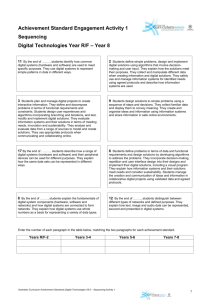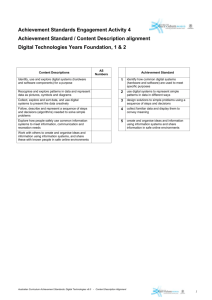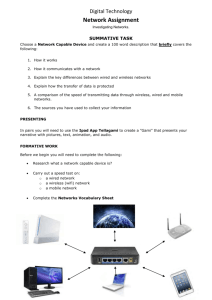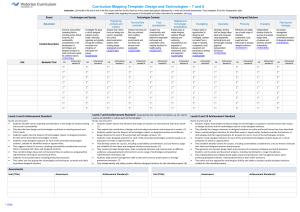Levels 7 and 8 (docx
advertisement
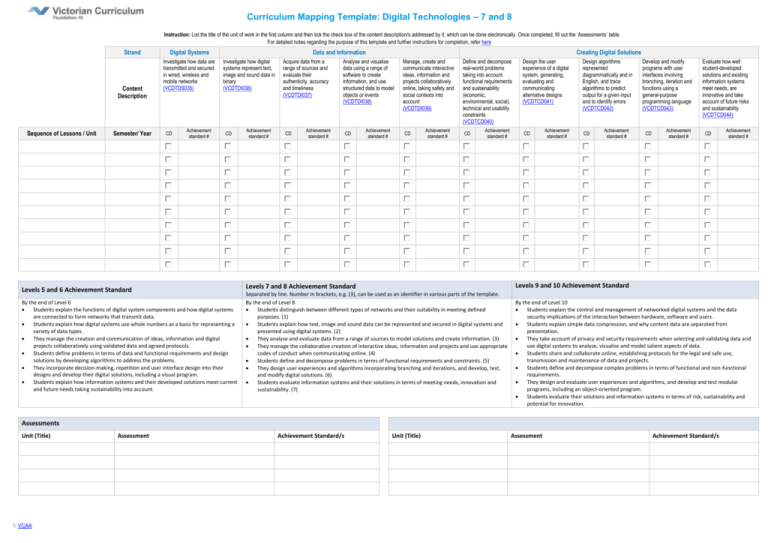
Curriculum Mapping Template: Digital Technologies – 7 and 8 Instruction: List the title of the unit of work in the first column and then tick the check box of the content description/s addressed by it, which can be done electronically. Once completed, fill out the ‘Assessments’ table. For detailed notes regarding the purpose of this template and further instructions for completion, refer here Strand Content Description Sequence of Lessons / Unit Semester/ Year Digital Systems Investigate how data are transmitted and secured in wired, wireless and mobile networks (VCDTDS035) CD Achievement standard # Data and Information Investigate how digital systems represent text, image and sound data in binary (VCDTDI036) CD Levels 5 and 6 Achievement Standard By the end of Level 6 Students explain the functions of digital system components and how digital systems are connected to form networks that transmit data. Students explain how digital systems use whole numbers as a basis for representing a variety of data types. They manage the creation and communication of ideas, information and digital projects collaboratively using validated data and agreed protocols. Students define problems in terms of data and functional requirements and design solutions by developing algorithms to address the problems. They incorporate decision-making, repetition and user interface design into their designs and develop their digital solutions, including a visual program. Students explain how information systems and their developed solutions meet current and future needs taking sustainability into account. Achievement standard # Acquire data from a range of sources and evaluate their authenticity, accuracy and timeliness (VCDTDI037) CD Creating Digital Solutions Analyse and visualise data using a range of software to create information, and use structured data to model objects or events (VCDTDI038) Achievement standard # CD Achievement standard # Manage, create and communicate interactive ideas, information and projects collaboratively online, taking safety and social contexts into account (VCDTDI039) CD Achievement standard # Define and decompose real-world problems taking into account functional requirements and sustainability (economic, environmental, social), technical and usability constraints (VCDTCD040) CD Achievement standard # Design the user experience of a digital system, generating, evaluating and communicating alternative designs (VCDTCD041) CD Achievement standard # Design algorithms represented diagrammatically and in English, and trace algorithms to predict output for a given input and to identify errors (VCDTCD042) CD Achievement standard # Develop and modify programs with user interfaces involving branching, iteration and functions using a general-purpose programming language (VCDTCD043) CD Achievement standard # Evaluate how well student-developed solutions and existing information systems meet needs, are innovative and take account of future risks and sustainability (VCDTCD044) CD Levels 9 and 10 Achievement Standard Levels 7 and 8 Achievement Standard Separated by line. Number in brackets, e.g. (3), can be used as an identifier in various parts of the template. By the end of Level 8 Students distinguish between different types of networks and their suitability in meeting defined purposes. (1) Students explain how text, image and sound data can be represented and secured in digital systems and presented using digital systems. (2) They analyse and evaluate data from a range of sources to model solutions and create information. (3) They manage the collaborative creation of interactive ideas, information and projects and use appropriate codes of conduct when communicating online. (4) Students define and decompose problems in terms of functional requirements and constraints. (5) They design user experiences and algorithms incorporating branching and iterations, and develop, test, and modify digital solutions. (6) Students evaluate information systems and their solutions in terms of meeting needs, innovation and sustainability. (7) By the end of Level 10 Students explain the control and management of networked digital systems and the data security implications of the interaction between hardware, software and users. Students explain simple data compression, and why content data are separated from presentation. They take account of privacy and security requirements when selecting and validating data and use digital systems to analyse, visualise and model salient aspects of data. Students share and collaborate online, establishing protocols for the legal and safe use, transmission and maintenance of data and projects. Students define and decompose complex problems in terms of functional and non-functional requirements. They design and evaluate user experiences and algorithms, and develop and test modular programs, including an object-oriented program. Students evaluate their solutions and information systems in terms of risk, sustainability and potential for innovation. Assessments Unit (Title) © VCAA Assessment Achievement Standard/s Achievement standard # Unit (Title) Assessment Achievement Standard/s
